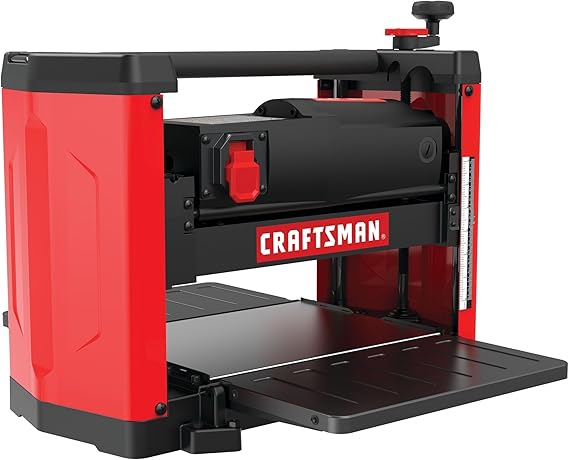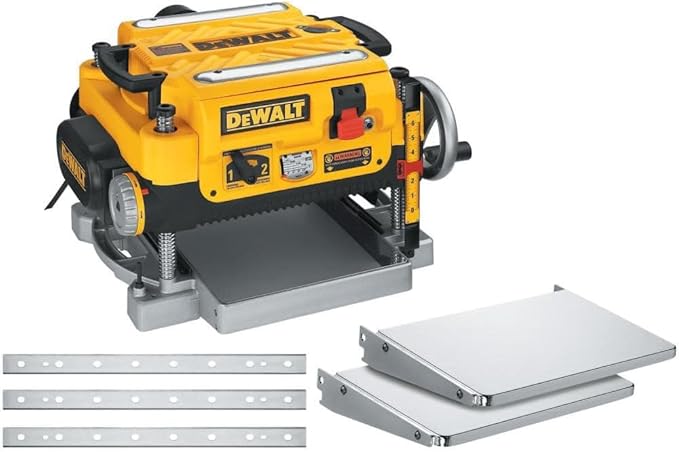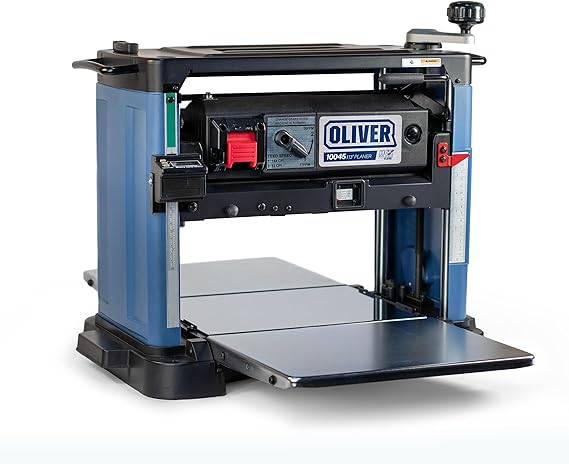Oliver Planer VS DeWalt DW735X VS Craftsman
Struggling to decide between the Oliver Planer, DeWalt DW735X, and Craftsman for your workshop?
Dealing with rough surfaces, imprecise cuts, or weak tools can ruin your woodworking projects. The Oliver Planer, DeWalt DW735X, and Craftsman CMEW320 are three popular choices, each offering unique features and benefits. But which one truly delivers the best combination of power, precision, and value for 2025?
In this article, we’ll compare these top contenders to help you decide which planer is the perfect fit for your workshop needs.

Craftsman vs Oliver vs DeWalt
When considering a thickness planer, most people are likely to be torn between the Craftsman, Oliver, and DeWalt models. Each of these planers has its own unique features and advantages, and we’ll explore them in detail to help you make the best choice.
Craftsman: A Budget-Friendly Option for Beginners

If you’re a beginner woodworker or have a tight budget, the Craftsman thickness planer might be an attractive option for you. Despite being the most affordable of the three, it still does a good job, with a few trade-offs.
Perfect Your Projects with the CRAFTSMAN Two Knife Planer – Click to Buy Now on Amazon!
Features:
- Carriage Lock: The Craftsman lacks a carriage lock, which may cause slight movements during planing. This can affect the accuracy of your thickness measurements.
- Depth Removal Gauge: While the Craftsman does have a depth removal gauge, it may not work as smoothly as those found on higher-end models.
- Cut Quality: With only two blades, the Craftsman may show more visible lines if you accidentally nick a nail or staple during planing.
DeWalt DW735X: A Solid Workhorse

The DeWalt DW735X is a popular choice among woodworking enthusiasts due to its solid build and reliable performance. It offers several features that make it a strong contender in the mid-range category.
Power Meets Precision – Get the DEWALT Thickness Planer on Amazon Now!
Features:
- Carriage Lock: The DeWalt doesn’t require a carriage lock because of its robust design, which minimizes any movement during planing.
- Depth Removal Gauge: The planer comes with an excellent depth removal gauge that allows for precise adjustments.
- Cut Quality: With a three-blade system, the DeWalt provides a smoother finish and is more forgiving if you encounter any obstacles during planing.
Additionally, the DeWalt offers two speeds (fine cut and rough cut), allowing you to optimize the planing process for different types of wood. Its depth gauge is superior to the Oliver’s, and the planer is generally easier to operate and maintain.
Oliver: A Sweet Spot for Price and Performance

If you’re willing to invest in a top-of-the-line thickness planer, the Oliver is an excellent option, especially for its Bird Shelex Helical Head.
Achieve Superior Precision – Buy the Oliver 13″ Helical Planer on Amazon Now!
Features:
- Bird Shelex Helical Head: The Oliver’s Bird Shelex head offers superior shearing of the wood, resulting in an incredibly smooth finish comparable to 120-grit sanding.
- Wixey Digital Readout Gauge: The planer features a precise digital readout gauge, allowing you to set the exact depth for your planing needs.
- Safety Magnetic Switch: The Oliver comes equipped with a safety feature that automatically turns the planer off in case of power loss, preventing unexpected restarts.
While the Oliver may lack a few convenience features found in the DeWalt, its Bird Shelex Helical Head and other high-quality components make it worth considering if you seek the best finish and durability.
Cut Quality and Finish: Making the Right Choice
When it comes to cut quality and finish, the Craftsman, Oliver, and DeWalt planers offer distinct performances.
Craftsman: Good, But Limited
The Craftsman planer delivers a good cut quality but may be less forgiving if you encounter obstacles like nails or staples. Since it utilizes a two-blade system, any damage to one of the blades can leave visible marks on the board’s surface.
Oliver: A Fine and Refined Finish
With its bird shelix helical head, the Oliver planer offers the finest and smoothest finish among the three. The shearing action of the shelix head results in an impressively refined surface, comparable to the result of sanding with a 120-grit paper.
DeWalt: Solid Cut Quality and Flexibility
The DeWalt planer may not provide the same level of refinement as the Oliver, but it offers a solid cut quality. With its three-blade system, it can handle small obstacles better, and the two-speed settings allow for rough cuts and fine finishing passes.
Snipe Reduction: A Pivotal Factor
Snipe, the frustrating issue of uneven cuts at the beginning and end of your board, is a significant concern for any planer user. Let’s see how each planer fares in snipe reduction.
Craftsman: Snipe Reduction Challenge
The Craftsman planer may require some adjustments to minimize snipe. Aligning the tables to have the front raised slightly higher than the middle table can help reduce snipe. However, achieving a snipe-free cut may be more challenging with this model.
Oliver: Avoiding Snipe with Carriage Lock
The Oliver planer comes equipped with a carriage lock, which effectively reduces snipe. By securing the carriage, you can expect more consistent and even cuts throughout your boards.
DeWalt: Minimal Snipe with Solid Design
Thanks to its ball screw mechanism and sturdy construction, the DeWalt planer experiences minimal snipe, especially when the carriage is locked down during planing.
Performance Comparison: Speed and Capacity
When it comes to performance, the three planers showcase varying capabilities in speed and cutting capacity.
Speed Test Results
In a speed test, the DeWalt planer demonstrated two speed settings: a slower, finer cut at 179 cuts per inch (CPI) and a faster, rough cut at 96 CPI. On the other hand, the Oliver and Craftsman planers performed similarly, providing a consistent cutting speed.
Cutting Capacity
While the Craftsman and Oliver planers can handle boards up to 12.5 inches wide, the DeWalt offers a slightly larger capacity at 13 inches. However, all three planers are compact and designed for space-saving convenience.
Build Quality: Is Price a Deciding Factor?
The build quality of a planer can significantly impact its longevity and performance. Let’s see how each planer stands in terms of construction and durability.
Craftsman: Budget Build
The Craftsman planer, being the most budget-friendly option, may not possess the same level of sturdiness as the other two models. Some users have noted that the plastic components and knobs feel less robust compared to the Oliver and DeWalt.
Oliver: Well-Balanced Build
The Oliver planer provides a well-balanced build with a sturdy metal bed and durable construction. However, the plastic top piece has been criticized for its potential to flex and could benefit from improvement.
DeWalt: A Solid Workhorse
The DeWalt planer is regarded as a workhorse with impressive build quality. Its solid construction and reliable components inspire confidence in its performance and longevity.
Convenience Features: Ease of Use Matters
Convenience features can significantly impact your overall experience with a thickness planer. Let’s take a look at how each model fares in this regard.
Craftsman: Simple Tool Storage
The Craftsman planer does have onboard tool storage for its wrench, which is useful for blade changes. However, some users have found it less accessible and may need improvements in design for more straightforward use.
Oliver: Tool Storage and Wixey Gauge
The Oliver planer offers onboard tool storage for easy access to the necessary tools. Additionally, it comes with the Wixey digital readout gauge, allowing for precise depth adjustments, which can be a valuable asset for certain projects.
DeWalt: Efficient Tool Storage and Safety
The DeWalt planer features onboard tool storage, making it convenient
to keep the necessary tools at hand. Moreover, its magnetic power switch provides an added safety feature by automatically restoring power after a power outage without the need for manual reactivation.
Portability and Storage: Compactness Matters
One of the primary advantages of benchtop planers is their compact size, making them easy to store and transport. Let’s see how each planer stacks up in terms of portability and storage.
Craftsman: Lightweight and Compact
The Craftsman planer’s thinner metal construction makes it a lighter and more compact option, offering easier portability and storage.
Oliver: Adequate Portability
The Oliver planer is still relatively compact and offers folding beds for storage. However, some users have reported minor annoyances with the folding mechanism not staying in place.
DeWalt: Compact and Sturdy
The DeWalt planer combines compactness with a solid build, making it easy to store and transport while maintaining its durability.
Final Verdict: Finding the Right Balance
Choosing the best thickness planer depends on your budget, specific needs, and desired level of performance. The Craftsman planer offers an excellent budget option for beginners, while the Oliver provides a sweet spot of price and performance, thanks to its bird shelix helical head. On the other hand, the DeWalt planer boasts solid build quality, convenience features, and minimal snipe.
Ultimately, if you seek the best overall value and performance, the DeWalt DW735X is the top choice. Its sturdy build, two-speed settings, minimal snipe, and option for future helical head upgrade make it a versatile and reliable thickness planer for any woodworking enthusiast.

